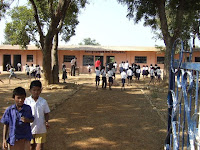Crisis and Opportunity: Education in India




The first photo is of Christina and her friend Mallory in front of their school. The second is of children at St. Stephen's Model School. The third is of two women preparing a lunch. The last is of children in a school courtyard.
MCC recently placed Christina Warner, a young American college graduate, as an assistant teacher at the St. Stephen’s Model School in Jagdeeshpur. She is a one-year volunteer serving with our Serving and Learning Together (SALT) program. St Stephen’s opened its doors this year in this rural town in the state of Chhattisgarh. The private English medium school is part of the pent-up energy to provide a quality primary education for rural children. India’s very young population makes it a Herculean task.
Many villages still do not have schools and the government schools that do exist are notoriously ineffective. Teachers regularly don’t even bother to show up for classes. Parents often don’t see the value of education compared to the small contribution that children can make to family income in their daily struggle to survive. As a consequence the dropout rate is astronomical. The average child completes less than five years of school in many parts of the country.
Literacy rates in India remain stubbornly low, especially in poor northern states. They cling at around 65% and only 54% of women are literate. Such dismal figures need a broader context lest we throw up our hands in despair. When India became an independent nation in 1947 it was still a largely agrarian society in which illiterate villagers worked for feudal landlords and literacy stood a 12%. When we start with this baseline, it becomes obvious that significant progress has been made since that time.
The British colonial government put little energy into primary education for common people. The schools that existed were largely designed to train administrators and civil servants to work in the colonial government and in businesses. Those involved in the Indian independence struggle had been trained in these schools and had serious misgivings about their Western, elitist orientation.
Gandhi, who was a product of the system and received his law degree in England, adamantly called the British school system ‘satanic.’ He even questioned the value of teaching literacy to villagers. In its place he promoted teaching ‘basic education’ that emphasized village handicrafts for boys and domestic skills for girls. His education program never got traction and proved to be one of his most miserable failures.
Independence leaders like Nehru paid lip service to the need to provide basic education but the new government never implemented a system of universal primary education. In the press of other concerns, education was relegated to the states. Funding was sparse and lost out to other priorities like military spending. The old elite system of education left behind by the British remained basically as it had been.
All this is now beginning to change as more and more families begin to realize that educating a child can be an opportunity to break out of the grinding cycle of poverty. The flourishing Information Technology industries and other forms of globalization have greatly increased the demand for English education. Middle class and even poor families who dream of a better life insist on an English education for their children.
Such families are abandoning poorly performing public schools in favor of private schools that are sprouting all over the place—even in simple roadside kiosks. English has ironically become the educational language of choice in multilingual India because it provides a vital link to the information highway and to economic opportunities beyond the confines of local communities. Few speak English as their first language but it has become a significant second language for 300 million Indians, perhaps the largest pool of English speaking people in the world.
I have seen some of the education challenges firsthand in rural India. Beside the St. Stephen’s Model School in Jagdeeshpur, I visited various former Mennonite mission primary and secondary schools. Some are more successful than others but all struggle, with very limited resources, to provide a quality education. Teaching materials are few and many children sit on the floor because desks and chairs are not available.
The state government provides salaries for a few teachers. Their pay of about $200 a month is good in a rural context. The government is, however, increasingly reluctant to provide such salaries and the church education boards that run the schools are only able to pay other volunteer teachers a very basic $32 a month. The government also provides a free lunch to students. This scheme allows poor families to send their children to school; it has dramatically increased attendance and decreased dropout rates in rural India.
We are at an educational intersection that is both a crisis and an opportunity. Nandan Nilekani insists that providing quality education to the next generation is our biggest challenge. According to him, “Our response will make all the difference between the world’s largest lumpen community of illiterates in an uncertain nation, and a country with a large pool of talented human capital that can fire up the economy to new levels of growth” (208).
Our MCC program in India is committed to the enormous challenge of providing a basic education for children from poor families. Through our Global Family program, we provide about 1,800 primary and vocational education scholarships each year for children from families that earn less than $120 a month. We monitor schools to ensure that students get a quality education. We are also scheming about how we can help make a more direct impact on the quality of education that students receive. Our educational work is one of our most socially transformative initiatives.
I am indebted to Nandan Nilekani, Imagining India: Ideas for the New Century, for some of my information in this blog posting.

